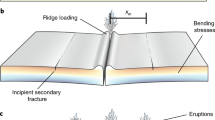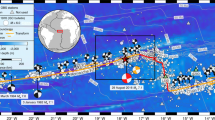Abstract
THEORETICAL calculations show1 that the occurrence of an earthquake leads to regions of increased shear stress on both sides of the ruptured fault. If this stress increase is sufficiently large, or if neighbouring faults are close to their failure stress, the result may be triggering of earthquakes on pre-existing faults in the region. A search for this effect2 produced only a few examples, all in continental areas, where clusters of aftershocks were located in the regions of increased stress. The linear dimensions of these clusters were generally less than 20 km, and less than one-half of the fault length that ruptured in the main shock. Here I report an example of this phenomenon in which the fault that is reactivated is a nearly 175-km-long segment of an oceanic fracture, and its length is comparable to that of the main shock, the 1989 Macquarie Ridge earthquake.
This is a preview of subscription content, access via your institution
Access options
Subscribe to this journal
Receive 51 print issues and online access
$199.00 per year
only $3.90 per issue
Buy this article
- Purchase on Springer Link
- Instant access to full article PDF
Prices may be subject to local taxes which are calculated during checkout
Similar content being viewed by others
References
Kostrov, B. V. & Das, S. Bull. seism. Soc. Am. 72, 679–703 (1982); Geophys. J. R. astr. Soc. 78, 19–33 (1984).
Das, S. & Scholz, C. H. Bull. seism. Soc. Am. 71, 1669–1675 (1981).
Braunmiller, J. & Nabelek, J. Geophys. Res. Lett 17, 1017–1020 (1990).
Ruff, L. R. (ed.) Geophys. Res. Lett. 17, 989–1024 (1990).
Anderson, H. J. & Zhang, J. J. geophys. Res. 96, 19853–19863 (1991).
Dewey, J. W. thesis, Univ. of California, Berkeley (1971); US. Geol. Sun. Prof. Pap. 1313, Q1–Q9 (1983).
Dziewonski, A. M., Ekstrom, G. E., Woodhouse, J. H. & Zwart, G. Phys. Earth planet. Int. 60, 243–253 (1990).
Dziewonski, A. M., Ekstrom, G. E., Woodhouse, J. H., & Zwart, G. Phys. Earth planet. Int. 62, 185–207 (1990).
Phys. Earth planet. Int. (1983–1990).
Engdahl, E. R., Billington, S. & Kisslinger, C. J. geophys. Res. 94, 15481–15498 (1989).
Ekstrom, G. A. & Engdahl, E. R. J. geophys. Res. 94, 15499–15519 (1989).
Cande, S. C. et al. Magnetic Lineations of the World's Ocean Basins (American Association of Petroleum Geologists, Tulsa, Oklahoma, 1989).
Ruff, L. J., Given, J. W., Sanders, C. O. & Sperber, C. M. Pure appl. Geophys. 129, 71–129 (1989).
Haxby, W. F., Karner, G. D., LaBrecque, J. L. & Weissel, J. K. Eos 64, 995–1004 (1983).
Aki, K. J. geophys. Res. 84, 6140–6148 (1979).
Author information
Authors and Affiliations
Rights and permissions
About this article
Cite this article
Das, S. Reactivation of an oceanic fracture by the Macquarie Ridge earthquake of 1989. Nature 357, 150–153 (1992). https://doi.org/10.1038/357150a0
Received:
Accepted:
Issue Date:
DOI: https://doi.org/10.1038/357150a0
This article is cited by
-
Strike-slip 23 January 2018 MW 7.9 Gulf of Alaska rare intraplate earthquake: Complex rupture of a fracture zone system
Scientific Reports (2018)
-
Research on seismic stress triggering
Acta Seismologica Sinica (2002)
-
Learning from the whispers
Nature (1993)
-
Changes in static stress on southern California faults after the 1992 Landers earthquake
Nature (1992)
Comments
By submitting a comment you agree to abide by our Terms and Community Guidelines. If you find something abusive or that does not comply with our terms or guidelines please flag it as inappropriate.



